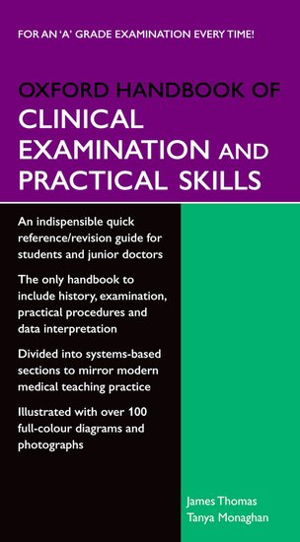
PublishedOxford University Press, May 2007 |
ISBN9780198568384 |
FormatSoftcover, 784 pages |
Dimensions18.4cm × 10.7cm × 2.1cm |
Your one-stop-shop for final examination, the Oxford Handbook of Clinical Examination and Practical Skills is the first truly comprehensive pocket guide to clinical examination and practical skills for medical students and junior doctors. Providing clear and user-friendly guidance on all aspects of history taking, physical examination, common practical procedures, data interpretation and communication skills, it gives realistic advice on coping with common situations.
In line with current teaching methods, the book takes a systems-based approach to medicine. Each system chapter follows a structured format covering applied anatomy, history, examination, and the presentation of common and important disorders. The procedures section includes approximately forty practical procedures that the final year medical student and senior nurse are expected to perform, from hand-washing through cardiopulmonary resuscitation to inserting chest drains. The theory, practice and complications are outlined for each.
The final section on data interpretation covers the basics of chest x-rays, abdominal x-rays, ECGs, lung function tests and several other areas that the junior doctor is expected to carry out in their early years of training. Aimed at medical students throughout their course and student nurses throughout their clinical years, its clear presentation and layout combined with comprehensive clinical detail make this book an ideal guide both for quick reference whilst on the wards, or for more detailed study at the desk. It will also prove useful to junior doctors and nurse practitioners as a primer before going out onto wards, or into a primary care setting.

